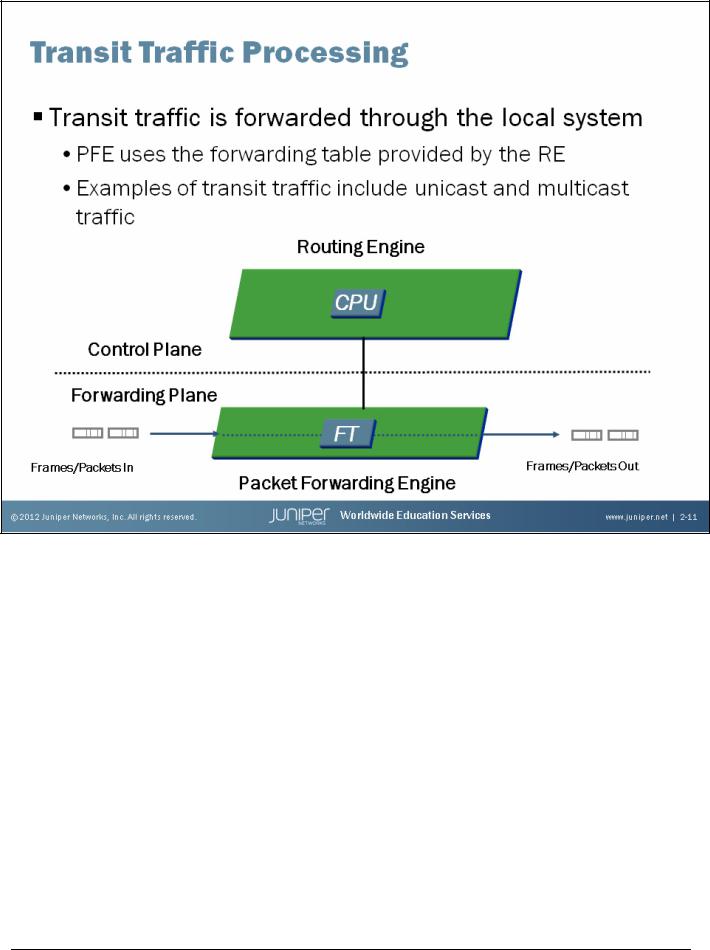
- •Contents
- •Course Overview
- •Course Agenda
- •Document Conventions
- •Additional Information
- •Chapter 1: Course Introduction
- •Chapter 2: Junos Operating System Fundamentals
- •The Junos OS
- •Traffic Processing
- •Overview of Junos Devices
- •Chapter 3: User Interface Options
- •User Interface Options
- •The Junos CLI: CLI Basics
- •The Junos CLI: Operational Mode
- •The Junos CLI: Configuration Mode
- •Lab 1: The Junos CLI
- •Chapter 4: Initial Configuration
- •Factory-Default Configuration
- •Initial Configuration
- •Interface Configuration
- •Lab 2: Initial System Configuration
- •Chapter 5: Secondary System Configuration
- •User Configuration and Authentication
- •System Logging and Tracing
- •Network Time Protocol
- •Archiving Configurations
- •SNMP
- •Lab 3: Secondary System Configuration
- •Monitoring Platform and Interface Operation
- •Network Utilities
- •Maintaining the Junos OS
- •Password Recovery
- •Lab 4: Operational Monitoring and Maintenance
- •Appendix A: Interface Configuration Examples
- •Review of the Interface Configuration Hierarchy
- •Interface Configuration Examples
- •Using Configuration Groups
- •Appendix B: The J-Web Interface
- •Configuration
- •Lab 5 (Optional): The J-Web Interface
- •Appendix C: Acronym List
- •Appendix D: Answer Key
- •Chapter 1: Course Introduction
- •Chapter 2: Junos Operating System Fundamentals
- •Chapter 3: User Interface Options
- •Chapter 4: Initial Configuration
- •Chapter 5: Secondary System Configuration
- •Chapter 6: Operational Monitoring and Maintenance

Introduction to the Junos Operating System
Traffic Processing
The slide highlights the topic we discuss next.
Chapter 2–10 • Junos Operating System Fundamentals |
www.juniper.net |

Introduction to the Junos Operating System
Transit Traffic
Transit traffic consists of all traffic that enters an ingress network port, is compared against the forwarding table entries, and is finally forwarded out an egress network port toward its destination.
A forwarding table entry for a destination must exist for a device running the Junos OS to successfully forward transit traffic to that destination. Transit traffic passes through the forwarding plane only and is never sent to or processed by the control plane. By processing transit traffic through the forwarding plane only, platforms running the Junos OS can achieve predictably high performance rates.
Transit traffic can be both unicast and multicast traffic. Unicast transit traffic enters one ingress port and is transmitted out exactly one egress port toward its destination. Although multicast transit traffic also enters the transit device through a single ingress port, it can be replicated and sent out multiple egress ports depending on the number of multicast receivers and the network environment.
www.juniper.net |
Junos Operating System Fundamentals • Chapter 2–11 |

Introduction to the Junos Operating System
Explain to the students that with some hardware the PFE does not handle the generation of ICMP messages.
Exception Traffic: Part 1
Unlike transit traffic, exception traffic does not pass through the local device but rather requires some form of special handling. Examples of exception traffic include the following:
•Packets addressed to the chassis, such as routing protocol updates, Telnet sessions, pings, traceroutes, and replies to traffic sourced from the RE;
•IP packets with the IP options field (options in the packet’s IP header are rarely seen, but the PFE was purposely designed not to handle IP options; packets with IP options must be sent to the RE for processing); and
•Traffic that requires the generation of Internet Control Message Protocol (ICMP) messages.
ICMP messages are sent to the packet’s source to report various error conditions and to respond to ping requests. Examples of ICMP errors include destination unreachable messages, which are sent when no entry is present in the forwarding table for the packet’s destination address, and time-to-live (TTL) expired messages, which are sent when a packet’s TTL is decremented to zero. In most cases, the PFE process handles the generation of ICMP messages.
Chapter 2–12 • Junos Operating System Fundamentals |
www.juniper.net |

Introduction to the Junos Operating System
The default built-in rate-limiting configuration applied to the internal link varies between Junos devices.
Exception Traffic: Part 2
The Junos OS sends all exception traffic destined for the RE over the internal link that connects the control and forwarding planes. The Junos OS rate limits exception traffic traversing the internal link to protect the RE from denial-of-service (DoS) attacks. During times of congestion, the Junos OS gives preference to the local and control traffic destined for the RE. The built-in rate limiter is not configurable.
www.juniper.net |
Junos Operating System Fundamentals • Chapter 2–13 |
